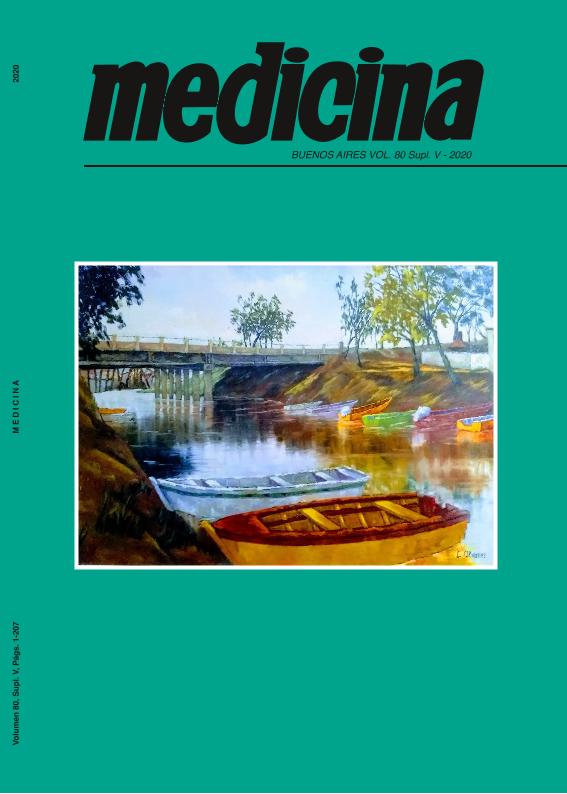Mostrar el registro sencillo del ítem
dc.contributor.author
Hernando, Guillermina Silvana

dc.contributor.author
Turani, Ornella

dc.contributor.author
Bouzat, Cecilia Beatriz

dc.date.available
2023-01-16T10:35:23Z
dc.date.issued
2020
dc.identifier.citation
Essential oils for the discovery of new anthelmintic compounds tested on the nematode Caenorhabditis Elegans; LXV Reunión Anual de la Sociedad Argentina de Investigación Clínic; LXVIII Reunión Anual de la Sociedad Argentina de Inmunología y Reunión Anual de la Sociedad Argentina de Fisiología; Buenos AIres; Argentina; 2020; 36-36
dc.identifier.issn
0025-7680
dc.identifier.uri
http://hdl.handle.net/11336/184774
dc.description.abstract
Parasitic nematodes of humans and animals cause dis- eases of major socio-economic importance globally. Con- trol of infections in both human and veterinary medicine currently relies mainly on chemotherapy, but resistance is an increasing problem, so there is an urgent need for discovery of novel drugs. As parasitic nematodes are not ideal laboratory animals, the free-living nematode C. ele- gans was demonstrated to be an excellent model system for the discovery of new anthelmintics and for character- izing their mechanisms of action and resistance. Essen- tial oils (EOs) are natural products produced by aromatic plants. EOs are complex mixtures that contain 2 or 3 ma- jor phytochemicals, which can be terpenes or aromatic compounds. We used paralysis assays of wild-type and mutant C. elegans strain to identify EOs with potential anthelmintic activities, reveal the active components, the target sites and the mechanisms of action. We found that EOs belonging to six different orders produced rap- id paralysis of C. elegans and we established the half maximal effective concentration values between 0.02-1.2 percent of EOs. All EOs tested also inhibited egg hatch- ing, a property related to anthelmintic ability. Thus, EOs mediate both rapid and long-term anthelmintic effects. We determined that trans-cinnamaldehyde (TC), a ma- jor component of C. verum EO, produces both paralysis and egg-hatching inhibition. By testing mutant worms, we identified the muscle L-AChR and GABA receptors as EOs and TC targets in vivo. Thus, by modulating two receptors with key roles in worm motility, these EOs emerge as novel sources of anthelmintic compounds. Likewise, the N-AChR mutant strain is slightly resistant to TC, thus revealing a third target receptor for terpenes. Due to the potential of EOs as sources of novel antipara- sitic compounds, additional studies will be carried out to determine in more detail the molecular mechanisms of action and structure-activity relationships of their active compounds.
dc.format
application/pdf
dc.language.iso
eng
dc.publisher
Fundación Revista Medicina
dc.rights
info:eu-repo/semantics/openAccess
dc.rights.uri
https://creativecommons.org/licenses/by-nc-sa/2.5/ar/
dc.subject
DRUG THERAPY
dc.subject
anthelmintic compounds
dc.subject
NEMATODE
dc.subject.classification
Bioquímica y Biología Molecular

dc.subject.classification
Ciencias Biológicas

dc.subject.classification
CIENCIAS NATURALES Y EXACTAS

dc.title
Essential oils for the discovery of new anthelmintic compounds tested on the nematode Caenorhabditis Elegans
dc.type
info:eu-repo/semantics/publishedVersion
dc.type
info:eu-repo/semantics/conferenceObject
dc.type
info:ar-repo/semantics/documento de conferencia
dc.date.updated
2022-11-01T22:13:37Z
dc.identifier.eissn
1669-9106
dc.journal.number
suplemento V
dc.journal.pagination
36-36
dc.journal.pais
Argentina

dc.journal.ciudad
Buenos Aires
dc.description.fil
Fil: Hernando, Guillermina Silvana. Consejo Nacional de Investigaciones Científicas y Técnicas. Centro Científico Tecnológico Conicet - Bahía Blanca. Instituto de Investigaciones Bioquímicas de Bahía Blanca. Universidad Nacional del Sur. Instituto de Investigaciones Bioquímicas de Bahía Blanca; Argentina. Universidad Nacional del Sur. Departamento de Biología, Bioquímica y Farmacia; Argentina
dc.description.fil
Fil: Turani, Ornella. Consejo Nacional de Investigaciones Científicas y Técnicas. Centro Científico Tecnológico Conicet - Bahía Blanca. Instituto de Investigaciones Bioquímicas de Bahía Blanca. Universidad Nacional del Sur. Instituto de Investigaciones Bioquímicas de Bahía Blanca; Argentina. Universidad Nacional del Sur. Departamento de Biología, Bioquímica y Farmacia; Argentina
dc.description.fil
Fil: Bouzat, Cecilia Beatriz. Consejo Nacional de Investigaciones Científicas y Técnicas. Centro Científico Tecnológico Conicet - Bahía Blanca. Instituto de Investigaciones Bioquímicas de Bahía Blanca. Universidad Nacional del Sur. Instituto de Investigaciones Bioquímicas de Bahía Blanca; Argentina. Universidad Nacional del Sur. Departamento de Biología, Bioquímica y Farmacia; Argentina
dc.relation.alternativeid
info:eu-repo/semantics/altIdentifier/url/https://www.saic.org.ar/revista-medicina
dc.conicet.rol
Autor

dc.conicet.rol
Autor

dc.conicet.rol
Autor

dc.coverage
Nacional
dc.type.subtype
Reunión
dc.description.nombreEvento
LXV Reunión Anual de la Sociedad Argentina de Investigación Clínic; LXVIII Reunión Anual de la Sociedad Argentina de Inmunología y Reunión Anual de la Sociedad Argentina de Fisiología
dc.date.evento
2020-11-10
dc.description.ciudadEvento
Buenos AIres
dc.description.paisEvento
Argentina

dc.type.publicacion
Journal
dc.description.institucionOrganizadora
Sociedad Argentina de Investigación Clínica
dc.description.institucionOrganizadora
Sociedad Argentina de Inmunología
dc.description.institucionOrganizadora
Sociedad Argentina de Fisiología
dc.source.revista
Medicina (Buenos Aires)

dc.date.eventoHasta
2020-11-13
dc.type
Reunión
Archivos asociados
